
Preparing ants for winter is a serious and crucial stage in the life of an anthill. By and large, almost all the efforts of the ant colony since spring are aimed at accumulating enough resources to survive the winter and ensure that a new generation of ants emerges before the start of frost. At the same time, many ants do not sleep at all in winter, as it may seem to an observer who does not see them for several months. Their life continues to boil, although not as rapidly as in summer.
How ants prepare for winter has been studied in detail by many scientists. In addition, amateur myrmecologists who keep ants at home are so familiar with the intricacies of hibernation of each species that today this process has been literally considered from all sides.
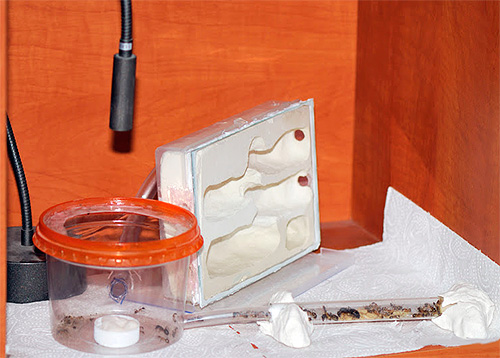
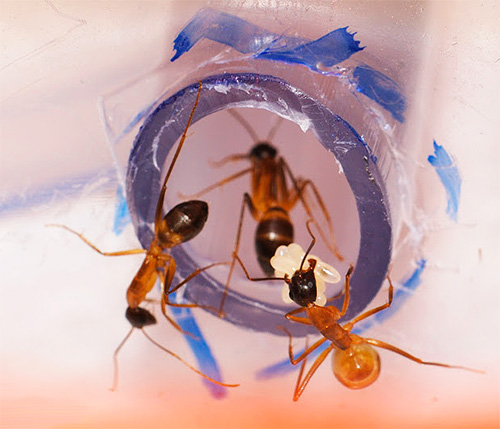
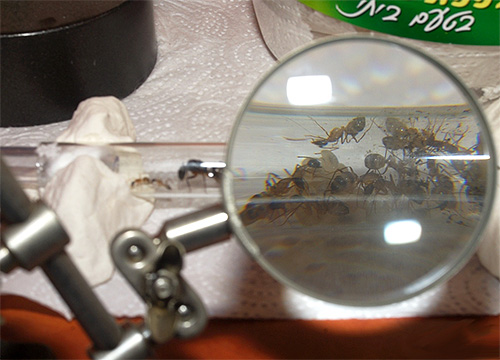
On a note
The science that studies ants is called myrmecology. Accordingly, a specialist who studies certain aspects of the life of ants is a myrmecologist.
Different ants hibernate in different conditions and at different times. The polar ant, for example, is forced to winter for 8-9 months a year, and in a few warm snowless months it does not always have time to feed a new generation of larvae. Nevertheless, wintering of ants, even in such conditions, usually proceeds quite successfully.
On the other hand, ants living in the south - in Central Asia, Kazakhstan, the Mediterranean - go to winter for one or two of the coldest months. And in transitional regions, for example, in Turkey and Asia Minor, they do not winter every year, but only under the most severe weather conditions. At the same time, they still prepare for winter at the end of the warm period - they collect seeds, equip an anthill, and feed a large number of larvae.
It is interesting
The ant familiar to us as pharaohs - a small domestic pest - does not hibernate at all and does not prepare for winter. He comes from the tropics, where climatic conditions change little during the year. And in Russian latitudes, for this reason, it can only live in a human dwelling - not being able to winter, under natural conditions, colonies of pharaoh ants on the street die out in winter.
Where and how is wintering
Ants overwinter in the same anthills in which they live the rest of the time. Most often, chambers deeper in the ground are used as wintering chambers, since they maintain a more stable temperature throughout the winter.
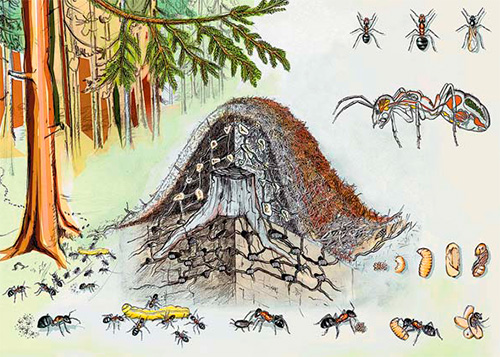
All entrances to the anthill for the winter are carefully sealed with earth and dry parts of plants so that cold air does not enter through them. In warm regions, during periods of thaw, individual entrances can open up and insects run out to the surface in search of food.
Some ants sleep in winter - this is the state of diapause, in which the functioning of the internal organs of insects is extremely reduced, but not stopped.
Other species remain active during wintering. As a rule, during this period they move little and eat little. But at the same time, if larvae overwinter in the anthill, adults continue to feed them.Such ants actively prepare for winter and collect larvae in chambers with an optimal microclimate.

It is interesting
Ants living in the harsh northern regions hibernate with severe hypothermia - in some of them, the body temperature can drop to minus 50 °!. And in the larvae of one of the ants in Kolyma, the minimum body temperature for insects in general was recorded - minus 58 ° C. At the same time, the metabolism of the larvae did not stop. In fact, this is a kind of natural phenomenon: at such low temperatures, all fluids in the body of any other living being freeze. In ants, when cold weather sets in, the amount of sugars in various body fluids increases sharply, due to which their freezing point constantly drops, and even with such extreme frosts they continue to remain liquids. Of course, in this state, the ants practically lose their mobility. You can tell they are asleep.
In some species of ants, only adults hibernate. As a rule, those species that do not have diapause differ in this, and insects in the anthill need to feed all year round. These ants are thoroughly preparing for the winter - they make stocks consisting of seeds, dried fruits and other parts of plants.
Ant larvae require protein food - other arthropods, for example - that adult insects cannot get for them. Accordingly, by winter, all the larvae from eggs laid in the spring have time to turn into adult ants, which leave for the winter. And in the spring, with the advent of the first protein food, the uterus begins to lay new eggs.

Worker ants of such species make original repairs in the anthill in winter, expand the chambers, monitor the observance of the microclimate.
In ants living in northern latitudes, the larvae do not have time to develop to adult insects in a short summer. They have to winter in a supercooled state.
In particularly extreme northerner ants that live at high altitudes, the larvae may overwinter twice before developing into adult ants. Usually, larvae of the third age, the most resistant to temperature extremes, overwinter.
It is interesting
In their distribution to the north, ants are limited only by a line beyond which, even in summer, the ground does not thaw deeper than 30 cm. was sufficient for the development of its larvae.
An anthill device for wintering
The anthill in winter for those ants that do not hibernate is practically no different from its summer state. Inside it, only the dislocation of the insects themselves changes: ants live somewhat deeper in winter, away from the cold surface of the soil. Sometimes they even have to make special wintering chambers.
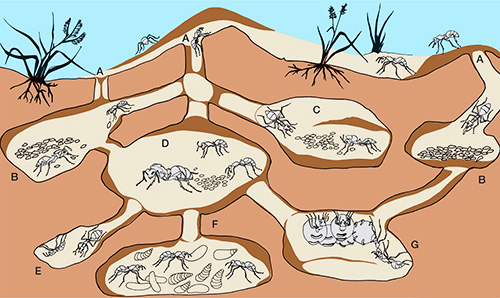
Due to constant temperature fluctuations on the surface, as well as due to the frequent wetting of the upper layer of the anthill, insects are forced to constantly move and transfer part of their reserves. That is why life in an anthill in winter does not stop for a moment.
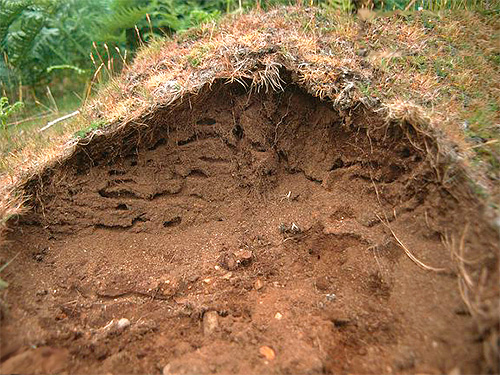
Forest ants, famous for the large size of their heaps of anthills, by winter try to bring to the surface as much earth and debris as possible in order to warm their house even more.This will allow them to winter in large enough quantities.
Ants begin to prepare for winter even in the hottest months of summer, gradually equipping the inner chambers of their dwellings and collecting food for the winter.
Judging by the data of the researchers, ants do not have a hard taboo on leaving the nest in winter. They simply move within the temperature limits at which the insect does not freeze. In most cases, such temperatures are maintained only inside the anthill. With the advent of the spring thaw, the anthill heats up, and the ants can get to the very exits. At a certain air temperature, insects open individual entrances and come to the surface. Sometimes this can happen even in the middle of winter.
It is interesting
The life of an anthill is tracked in particular detail in formicaria - artificial anthills with glass or plastic transparent walls. Fans who keep ants in such cages are forced to arrange wintering for them on balconies or in refrigerators. At this time, insects are fed and regularly open the entrances to the anthill for ventilation. The video below shows such an anthill. The ants hibernate in the same chambers.
Home ant farm
Do ants stock up for the winter
Almost all hibernating ants stock up for the winter. Even representatives of species that winter in extreme conditions, due to stored plant and animal remains, live part of the autumn, when the anthill is already covered with snow, but the temperature in it does not drop to too low values.
Ants make stocks for the winter almost all the warm season.In most species of central Russia, summer occurs in May-June, and immediately after it, part of the nutrients brought into the anthill is transferred to special chambers in which low humidity and temperature are maintained.
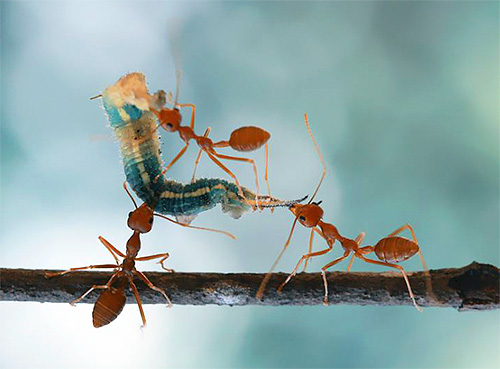
It is interesting
Reaper ants living in the steppe regions collect up to a kilogram of various grains in one anthill for food in winter. Almost all summer and autumn they prepare for winter.
As a rule, stocks mainly consist of plant products - plant seeds, buds, flowers, soft green stems. They have a long shelf life and are highly nutritious.
Some ants, not wanting to part with delicacies, carry even aphids underground, which continue to share honeydew with them. Of course, aphids die from lack of food for several weeks, but this is enough for ants.

It is interesting
Ants sometimes use so-called trophic eggs to feed the queen. The uterus itself lays them in the summer, with an excess of feed, and until the winter they do not develop, but continue to retain a large amount of nutrients. Such eggs are a kind of canned protein for insects.
In addition to aphids, many anthills are inhabited by various insects - beetles, moths, their larvae - which secrete a nutritious and sweet secret that ants like, and they themselves feed on ant stocks or even their eggs. In part, such neighbors also help adult ants to overwinter without starvation.
In a huge family of ants, there are species that are strictly hibernating on the northern borders of their range, and not hibernating at all in the south.It is believed that the process of preparing for wintering is launched by the ants themselves in response to various environmental conditions: a change in the length of day and night, the general composition of food, and other factors. All this helps insects to make the most of all the opportunities for survival and reproduction that the environment provides them.
Do-it-yourself ant farm: video

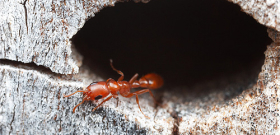
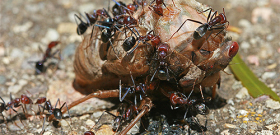

Good article!